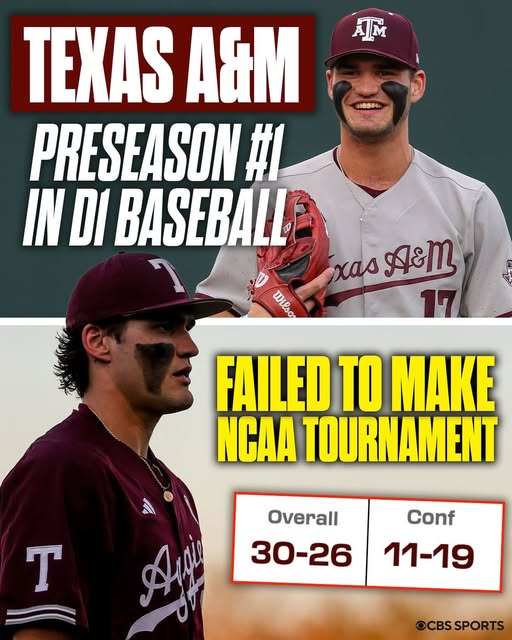Texas A&M’s Disappointing Descent: From Preseason Hype to NCAA Tournament Omission
In the volatile world of college basketball, expectations are everything. For Texas A&M, the 2024-25 season began with promise, high rankings, and bold projections. Buzz Williams’ squad entered the year as a preseason Top 25 team, with many pundits calling them a dark-horse candidate to make a deep run in March. But instead of dancing in the NCAA Tournament, the Aggies found themselves on the outside looking in—once again. It’s a sobering outcome for a program that has invested heavily in talent, development, and culture, only to stumble when it mattered most.
This wasn’t how it was supposed to go. A roster filled with veteran leadership, experience in the backcourt, and a tough, defensive-minded identity had many believing Texas A&M could not only return to the NCAA Tournament but potentially contend for an SEC title. Yet as the season wore on, the Aggies slowly unraveled. A mix of inconsistency, injuries, offensive stagnation, and a brutal SEC slate left them grasping for answers and ultimately falling short of their postseason ambitions.
To fully understand the sting of this failure, one must revisit the optimism that surrounded the team in October. Analysts from ESPN, CBS Sports, and The Athletic praised the Aggies for returning their core nucleus from the previous season. Star guard Wade Taylor IV, who flirted with NBA Draft waters before deciding to come back, was expected to be among the best point guards in the country. His scoring ability, decision-making, and on-court leadership made him the heartbeat of the team. Alongside him, Tyrece Radford brought toughness and defensive tenacity, while forward Henry Coleman III provided inside presence and rebounding muscle.
Buzz Williams, now in his sixth year in College Station, appeared to have finally solidified the foundation of his program. After narrowly missing the NCAA Tournament in 2022 and making a first-round exit in 2023, many thought this was the year everything clicked. The offseason training videos were intense. The interviews were filled with belief. And in the early stages of non-conference play, the Aggies even looked the part.
They earned a few solid wins in November and December, showing flashes of the defensive grit that Williams teams are known for. They were rebounding well, contesting shots, and grinding opponents into low-percentage looks. But the cracks in the armor soon became evident. Offensively, the team was too dependent on Taylor to create. When defenses keyed in on him, the rest of the offense often sputtered. Three-point shooting was unreliable. Ball movement stagnated. And in close games, execution fell apart in crunch time.
Losses began to pile up in conference play, and none were more damaging than defeats to teams in the lower tier of the SEC standings. Texas A&M dropped games it couldn’t afford to lose—to teams like Georgia, Missouri, and Vanderbilt. Each missed opportunity chipped away at their NCAA Tournament résumé. And while there were moments of hope, such as an overtime win against Alabama and a gritty performance against Kentucky, the inconsistency defined their season.
By late February, the writing was on the wall. Bubble projections placed A&M outside the field of 68. Every game became a must-win, but the Aggies lacked the offensive firepower to consistently rise to the moment. Their SEC Tournament run was short-lived, and any lingering dreams of stealing a bid by winning the conference crown evaporated in disappointing fashion.
Perhaps the most frustrating aspect of the season was how often Texas A&M lost close games. Their margin for error was slim, but they repeatedly came up just short in contests decided by five points or fewer. That inability to finish late in games—due to poor free-throw shooting, costly turnovers, or stagnant late-clock possessions—exposed a lack of composure that veteran teams are supposed to possess.
Buzz Williams now faces serious questions about the direction of the program. While his tenure has seen moments of promise and overachievement, this season felt like a step backward. For a team with so much continuity, experience, and preseason buzz, missing the tournament is not just a disappointment—it’s a failure. And one that could have lasting implications.
Recruiting is a critical piece of the puzzle, and while Texas A&M has landed a few promising prospects, they’ve struggled to compete with the elite programs in the SEC when it comes to stacking blue-chip talent. Without a consistent influx of game-changing players, it becomes difficult to keep pace in a league that continues to rise in national prominence. Programs like Alabama, Auburn, Tennessee, and Kentucky continue to attract top-tier athletes, and even mid-tier programs like Ole Miss and Florida have elevated their rosters through smart recruiting and portal acquisitions.
Speaking of the portal, Texas A&M’s usage of the transfer market has been hit or miss. Some additions have brought value, but there’s been a lack of consistent offensive production from the wings and bigs. The team sorely missed a true stretch forward who could space the floor and open lanes for Taylor to operate. Too often, the floor felt cramped. Drives were met with walls of defenders. Kick-outs were met with missed threes. It was a pattern that played out far too frequently.
Fan frustration has also reached a boiling point. Reed Arena, once a place of enthusiasm and optimism, had noticeable pockets of empty seats by season’s end. Social media turned hostile. Message boards filled with criticism of the coaching staff, player development, and game management. While most still respect what Williams has done to stabilize the program in the post-Billy Kennedy era, patience is wearing thin. A strong start to next season is no longer optional—it’s required.
Looking ahead, the roster will likely undergo significant change. Wade Taylor IV could still decide to turn pro, and if he does, the Aggies will lose their leading scorer and emotional leader. Tyrece Radford’s eligibility is up. Coleman’s status is uncertain. That means Williams and his staff will be forced to dip into the transfer portal to replenish talent and inject life into a team that simply wasn’t good enough.
Beyond the individual names, though, Texas A&M must reassess its offensive identity. Defense has been the calling card, but the modern game demands more creativity, spacing, and pace. The best teams in the nation can win games in the 60s or 80s, depending on the opponent. A&M too often gets stuck in one gear—and it’s not fast. Adjusting their offensive philosophy, improving player skill development, and evolving with the modern game are necessary if the Aggies want to avoid a similar fate next March.
As the NCAA Tournament unfolds without them, Texas A&M is left with an offseason of what-ifs. What if they’d hit free throws down the stretch against LSU? What if they’d avoided the collapse against Georgia? What if the offense had found a second reliable scorer? What if Buzz Williams had found a way to better utilize the pieces on the roster?
Those questions won’t be answered anytime soon. What is clear, however, is that a season that began with so much promise ended in bitter disappointment. For a program that believes it belongs among the nation’s best, the standard has not been met.
Texas A&M basketball still has a passionate fan base, strong resources, and the potential to compete. But potential doesn’t get you into the tournament. Wins do. And for all the hype, promise, and preseason talk, the Aggies didn’t win enough. That’s the harsh truth. And until that changes, they’ll continue to watch March Madness from home.



